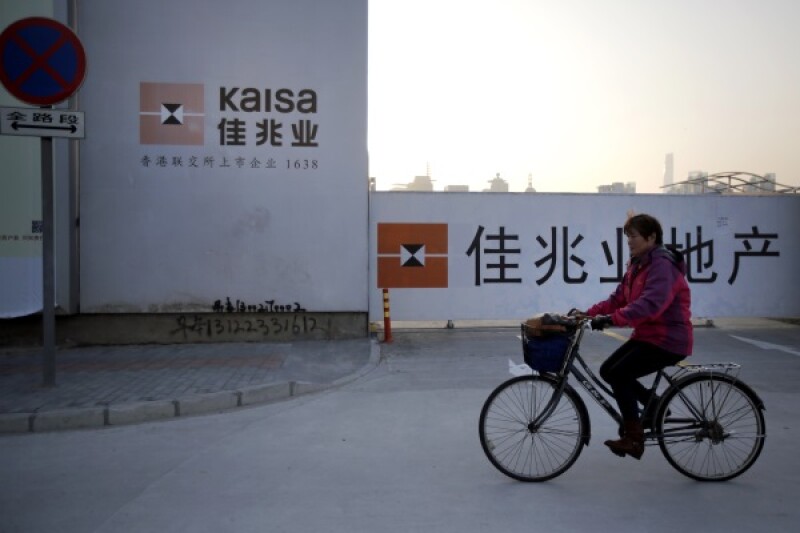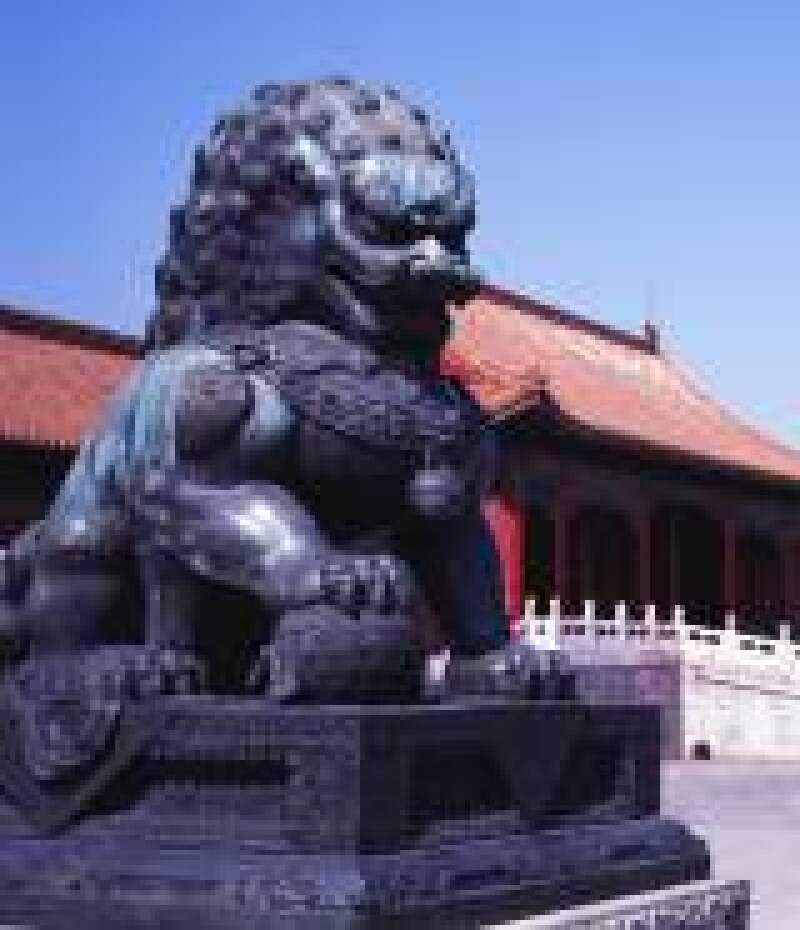
|
A cyclist rides in front of a construction site by Chinese property developer Kaisa Group in Shanghai |
When Kaisa became the first Chinese property developer to officially miss offshore obligations – failing to honour $51.6 million of coupons on two of its outstanding dollar bonds in April – the market responded not with a bang but with a whimper.
Secondary prices barely budged. Just three days later, Jingrui Holdings, rated B3/B, priced a $150 million 13.25% 2018 bond at par. The following month’s monetary stimulus from the People’s Bank of China, together with Beijing’s efforts to boost property demand, unleashed further supply. Agile Property, rated Ba3/BB-, raised $500 million from a $1.5 billion order book in early May. Meanwhile, lower down the credit curve at B2/B/B+, China Aoyuan priced a $250 million bond on May 18 offering a 11.25% yield.
The primary market hospitality for property developers after Kaisa’s default contrasts with the 2011 Sino-Forest saga that shut out Chinese industrial borrowers for at least six months.
Overweight
For all the doom and gloom over Chinese private-sector debt sustainability, a clutch of brokers and cash-rich fund managers are overweight Chinese property developers. The sector’s weighted average yield was at its tightest year-to-date level, in late May, at 8.3%, according to CreditSights, despite the sector’s elevated leverage, weak margins and excess capacity.
Investor complacency might be sowing the seeds of trouble.
The Kaisa saga should be seen as a poster-child for the systemic risks in the Asian high-yield sector, which is particularly biased towards China-centric credits with property developers from the mainland representing some 40% of the debt stock.
While onshore creditors rushed to take legal action in the Kaisa case, foreign investors – who remain deeply subordinated in the creditor hierarchy, with little recourse to mainland China assets – had to sit on the sidelines.
China’s anti-corruption drive is weakening implicit corporate guarantees. Investors should redouble efforts to review covenants and accounting norms in the quoted real-estate sector, say analysts.
Dilip Parameswaran, head of Asia Investment Advisors, an independent consultancy in the Asian fixed income markets, says: “I think there will be more defaults. So far, defaults have occurred for business or corporate governance reasons. Kaisa is the first default because the government got involved. This is a problem for the credit community: no one can read the political risk. Valuations for high-yield bonds will have to reflect that.”
Kaisa, a formerly double-B credit, failed to honour loan obligations last year, precipitated by the December 31 departure of its chairman, Kwok Ying Shing, after business operations in its home base, the southern city of Shenzhen, were abruptly blocked by authorities.
There has been no explanation from mainland authorities for its actions against the company, which, before the regulatory intervention, was seen to be in decent financial health with a cash balance of $1.7 billion in June 2014.
While lax financial disclosure and weak corporate governance have contributed to the developer’s bruised fortunes, the event principally underscores key man risk for investors exposed to developers in China, which often rely on personal connections to acquire the rights to government-approved land projects, say analysts.
Way back
Kwok’s mysterious return as chairman in April, a partial resumption of its business operations and an offer by Sunac China Holdings to acquire a 49.3% stake held in the Kwok family trust – pending an overhaul of its $7.6 billion debt burden – has triggered a recovery in the distressed notes.
However, on May 28, Sunac walked away from the deal. Chinese media reported that Kwok himself had reconsidered it because of improving Shenzhen property prices.
The question is whether Kaisa will be an isolated case. Some $6 billion of Chinese property bonds will mature in 2016, double 2015 levels, rising to $8 billion in 2017 and $10 billion in 2018. However, Moody’s expects Asian high-yield corporate default rates to stay low at 2.9% in 2015, citing, in part, the sector’s access to liquidity, while management at property firms are shifting away from expansion to clearing existing inventory and moderating capex.
But there are pressure points.
Senior executives at Agile Properties were detained last year, again with no official explanation. Meanwhile, Renhe Commercial Holdings relieved investors after it repaid 2015 dollar bonds in mid-May, following bondholders’ rejection of the issuer’s buyback attempt at a deep discount in December. Rating agencies have also flagged the risk that falling sales might inhibit Glorious Property’s offshore debt-servicing capacity after missing loan repayment deadlines in recent months.
The Kaisa saga underscores the urgent need to redouble credit analysis. But analysts and investors are unable to apply risk premia to cover different degrees of contingent government support to Chinese real estate developers.
A seller’s market
It’s still a seller’s market. Sandra Chow, Asian high-yield corporate analyst at CreditSights, says: “We have not seen a lot of foreign investors in many deals this year [with an average 78% Asian participation in order books for deals year-to-mid-May]. Most of the issuance since Kaisa has come from seasoned issuers, so deals have been priced fairly quickly, often without any pushback from investors with respect to disclosure or governance concerns.”
Further reading |

|
One Singapore-based multi-asset fund manager adds: “There are cash-rich fund managers that have new mandates to invest in Asian high yield and, as such, have no choice to invest in Chinese property markets. This demand is unhealthy for credit standards.”
In recent months, a slew of property developers have amended bond covenants to boost their financial flexibility to finance dividends, buybacks or investment. Underscoring weaker investor protection for event risk in covenants, Country Garden’s negative-ratings conditions specify that a downgrade by two rating agencies, rather than the usual one, is required before bondholders are permitted to put their bonds, in the event of a change-of-control situation.
Parameswaran says issuers could boost investor protection by placing reserve accounts offshore to boost debt-servicing capacity in the event of financial distress during repayment periods.
And there is accounting risk. Joint-venture firms have access to financing and collateral from a number of opaque sources on the mainland, allowing them, in theory, to flatter capital ratios. In addition, 11 issuers have now borrowed through the perpetual bond market, according to Moody’s, including Evergrande Real Estate Group, whose total outstanding perp obligations exceed the group’s common equity. While perps are counted as equity for accounting purposes, the principal would need to be repaid during a liquidation event.
Offshore subordination
The Kaisa saga has also reawakened the issue of foreign investors’ structural subordination in the creditor hierarchy for offshore bonds, thanks to capital controls. In short, onshore Chinese subsidiaries – typically the main operating subsidiaries that operate and own most of the group’s assets and consolidated debt – can’t provide explicit guarantees for bonds of offshore entities unless the proceeds are used for offshore purposes.
As a result, few companies sell bonds abroad directly. Instead, property developers typically issue through offshore listed companies and, in some case, sweeten investor protection through keepwell deeds, which were first introduced by property developer Gemdale in 2012. This is effectively a letter of intent issued by the onshore parent to honour bond obligations in the event of distress.
Never tested
The keepwell structure, and other forms of credit enhancement, has never been tested in a bankruptcy process, and is a weaker form of protection than an outright guarantee from the parent, which requires regulatory approval.
While Kaisa obligations don’t contain keepwell deeds, the default on its 2017 and 2018 notes is a reminder of foreign investors’ subordination and renews questions over investor protection. The opacity of the terms of onshore loan arrangements of Kaisa and other developers is also vexing credit analysts.
Referring to trust products, which are secured bank loans, Franco Leung, China property analyst at Moody’s, says: “Whether investors are successful in getting greater transparency from issuers about the covenants in their bank loans remains to be seen.”
One Singapore-based fund manager sums up his outlier opinion on supply: “I think Kaisa could be a positive development – it could structurally shrink the supply of Asia high-yield property bonds. As an investor, I don’t want to have to deal with these subordination issues – keepwells are not the same as guarantees – and as China liberalizes its capital account, onshore opportunities should expand.”
Edward Al-Hussainy, a fixed income strategist at Peridiem Global Investors, concludes on the bigger picture. “I expect the government to continue to signal its bias towards stability by orchestrating periodic defaults but pumping in credit to calm the market and tilting the bankruptcy process in favour of local bondholders.”